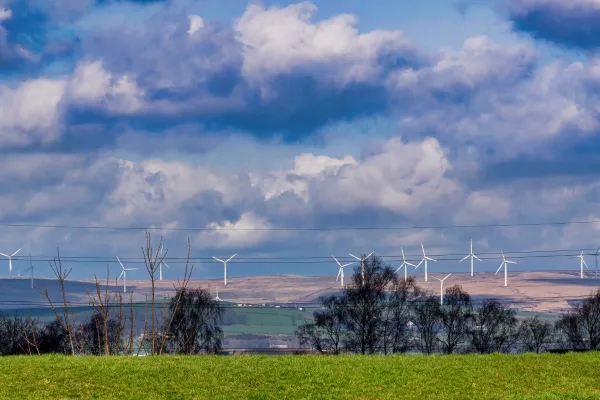
Onshore Wind is Back: Inside the UK’s 40-Point Strategy
Onshore Wind is Back: Inside the UK’s 40-Point Strategy
For almost a decade, onshore wind in England was effectively sidelined by restrictive planning rules. While Scotland, Wales and Northern Ireland pressed ahead with projects, England saw a near standstill in deployment. This policy vacuum left one of the cheapest, fastest and most scalable forms of clean energy largely untapped.
That era is over. In 2025, the UK Government launched its first-ever Onshore Wind Strategy, a centrepiece of the 40-point environment plan. The aim is simple but ambitious: to remove barriers, accelerate deployment, and put onshore wind at the heart of the UK’s net zero journey. Ministers now call it a “no-brainer” — onshore wind cuts bills, strengthens energy security, and delivers jobs as well as climate benefits.
The State of Play
Onshore wind already plays a significant role in the UK’s energy system:
Installed capacity now exceeds 16 GW, powering the equivalent of around 10 million homes.
In 2023, onshore wind contributed over 11% of UK electricity, its highest-ever share.
Combined with offshore wind, total wind generation provided 28.7% of the nation’s electricity — more than gas, and far beyond coal.
The majority of this capacity sits north of the border. Scotland is home to some of Europe’s most productive wind farms, while Wales and Northern Ireland also contribute strongly. England, however, lags far behind, with just a handful of large sites due to planning constraints introduced in 2015.
Reversing this imbalance is now a strategic priority.
Breaking Down the 40 Actions
The Onshore Wind Strategy sets out more than 40 actions to get turbines turning faster. Highlights include:
1. Faster Planning & Consenting
Large onshore wind farms will once again be eligible for the national infrastructure planning regime, meaning they can bypass years of local uncertainty. Councils will also receive better tools and data to support quicker, evidence-based decision-making.
2. Tackling Aviation & Radar Barriers
Conflicts between turbines and radar systems currently block around 10 GW of potential projects. New tech solutions and closer collaboration with the Ministry of Defence aim to unlock this capacity.
3. Repowering the Old Fleet
Many early UK wind farms are 20+ years old. Repowering allows developers to replace dozens of small 1990s-era turbines with fewer, taller, more efficient models — multiplying output without expanding land use.
4. Delivering Community Benefits
Host communities will receive at least £5,000 per megawatt per year. At full deployment, this could mean £70 million annually invested into local projects, bill discounts or community services.
5. Jobs and Supply Chain Growth
The sector currently employs around 20,000 people. With supportive policy, that figure could more than double to 45,000 by 2030, as investment flows into UK-based manufacturing, installation and maintenance hubs.
6. Investment Signals
Onshore wind is firmly back in the Contracts for Difference (CfD) auctions, securing long-term price stability. In 2022, nearly 0.9 GW won contracts at record-low prices (£42–45/MWh) — making onshore wind one of the cheapest forms of new power available.
Signs of Momentum
The strategy isn’t just words — change is visible on the ground.
In 2024, the Viking Wind Farm in Shetland (443 MW) came online, the UK’s largest onshore project in nearly a decade. It will generate 1.8 TWh annually, enough to power Birmingham.
Repowering projects are gaining traction, replacing outdated turbines with modern ones that deliver far more power from the same land footprint.
National generation from onshore wind grew 23% year-on-year in 2024, underscoring the sector’s potential once barriers are removed.
But industry leaders warn that delivery must now catch up with ambition. Project pipelines in England remain thin after the “lost decade” of stalled development.
Looking Ahead
The government’s Clean Power 2030 plan sets a target of 27–29 GW of onshore wind by 2030, nearly double today’s capacity. By 2035, this could rise to 35 GW, helping achieve the overarching goal of a fully decarbonised power system.
To get there, several enablers will be critical:
Grid Upgrades: The UK has introduced a “first ready, first connected” system to cut connection delays that previously stretched to 2035. National Grid’s Great Grid Upgrade will expand north–south transmission routes.
Public Investment: The new Great British Energy company will co-invest in projects, supporting private developers and unlocking additional capital.
Workforce Development: Training programmes and supply chain incentives will be essential to scale up jobs and UK-based manufacturing.
Community Partnerships: The new benefits framework aims to embed local support, ensuring projects bring value to the people living closest to them.
If these measures are delivered at pace, onshore wind could become a cornerstone of the UK’s clean power system, driving both climate action and economic renewal.
Why It Matters
For the industry, the opportunity is enormous:
Developers will benefit from a clearer, faster planning system and access to CfD auctions.
Investors can deploy capital into one of the UK’s cheapest and most scalable energy sources.
Supply chains stand to grow, with new jobs in turbine manufacturing, civil works and maintenance.
Communities will see direct benefits, from local funding to lower bills.
Most importantly, expanding onshore wind strengthens energy security by reducing reliance on imported gas, cuts bills through low-cost generation, and accelerates the path to net zero.
Final Thoughts
After years of stagnation, the UK’s onshore wind sector is finally back in motion. The new strategy represents a decisive policy shift — one that recognises onshore wind as a vital, cost-effective part of the future energy mix.
But success will depend on delivery. The government, industry and grid operators must now work together to translate the 40 actions into real projects. If they succeed, onshore wind won’t just power millions of homes — it will power local economies, secure Britain’s energy future, and cement the UK’s role as a global clean energy leader.
